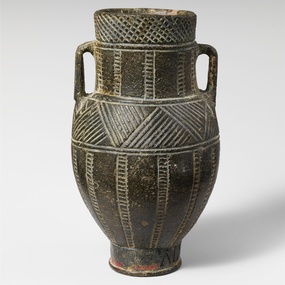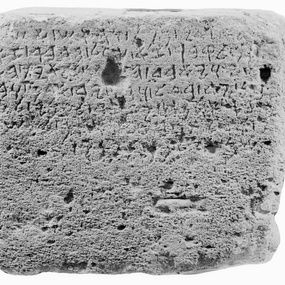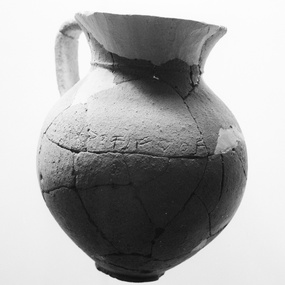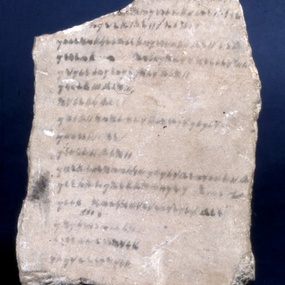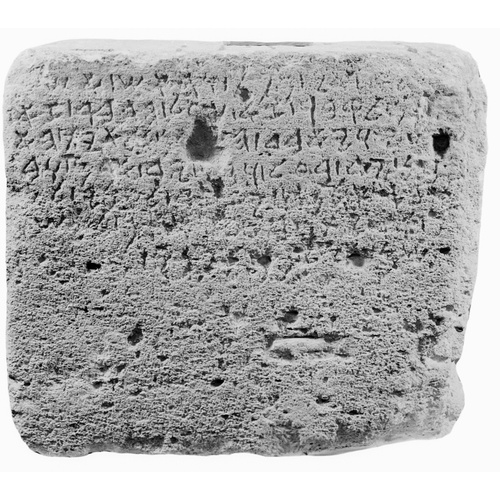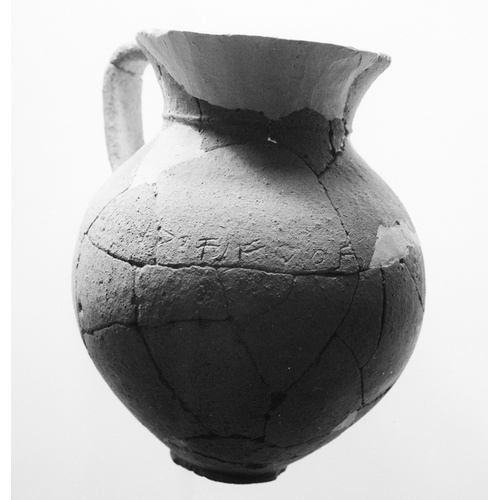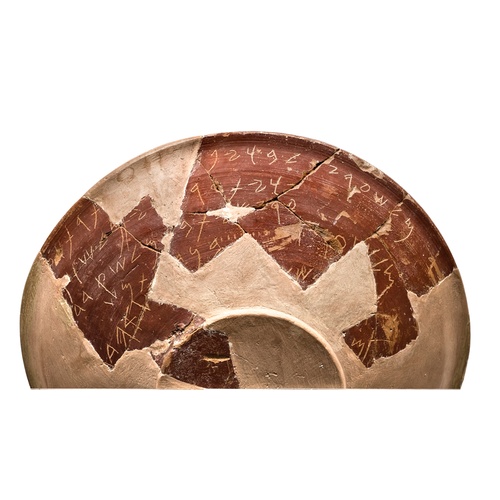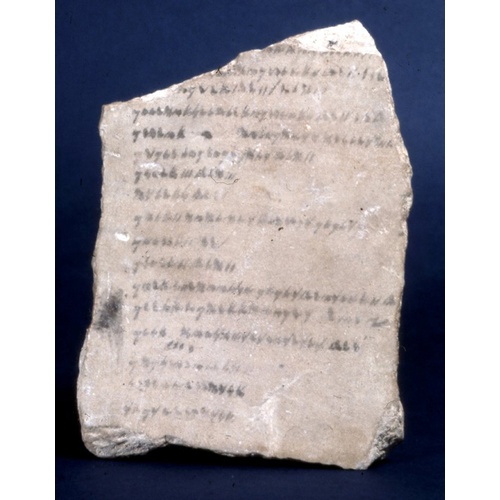The preamble of their relations
The geographical proximity of Cyprus to the Near East was the primary reason for relations between the two regions. Situated between the Aegean Sea and the Near East, Cyprus managed to acquire a dominant role by skillfully handling the geopolitical changes in its region1 and by taking advantage also of her natural resources.2 From as early as the 18th century BC, it exports significant quantities of copper and plays a decisive role in the maritime trade-networks.3
The island develops a complex institutional framework from the 15th century BC and rises to the ascendancy in the 14th century BC as a significant political power.4 The island appears under the name “Alashiya”5 in the texts of the Near East particularly from Mari, Babylon and Alalakh6 already from the 18th century BC, in texts from Hattusa dating from the late 15th century to the early 12th century BC7 and in the records of Ugarit dating from the 14th to the early 12th century BC.8 In Egyptian archives written in hieroglyphic script and dating from the mid-15th century BC, we read two identical terms, “asija” (isy) and “alasa” (irs) that define “Alasia”.9 In the Archives of the capital of Akhenaten, Amarna, 382 clay tablets were found inscribed in Akkadian that was considered to be the common diplomatic language of the time. These tablets included the correspondence between the king of Alasia and the Egyptian Pharaoh of the 14th century, and documented that the island had a leading role in the economy of the east Mediterranean.10 The only - so far - known name of the king of Alasia is Kušmešuša and according to Peltenberg11 he was probably in power at the end of 13th century BC. Kušmešuša addresses the king of Ugarit as “son”, a designation that places him hierarchically above the king of Ugarit. In the same text we read that Kušmešuša sends 33 copper ingots, equivalent to 900 kilos of copper, to the king of Ugarit, demonstrating the natural wealth in the states of eastern Mediterranean in the Late Bronze Age,12 as well as their ability to export and distribute copper.
The most recent occurrence of the name Alasia is in the 11th century BC tale of Wenamun,13 an Egyptian priest who travelled from Egypt to Byblos to fetch timber. On his return he was windswept to Alasia. The papyrus that records his adventures on the island is a secondary source of information about the existence of an organized political system in Cyprus, since Wenamun reports that on his arrival in Alasia he was received by Queen Hatbi.14 These two names, Queen Hatbi and King Kušmešuša, are the only existing references to royals of the Late Bronze Age. The island reemerged in the inscriptions of the Assyrian potentates Esarhaddon and Ashurnasirpal as early as the 7th century BC with the name Iatnana, where it appears divided into city-states dominated by local rulers.15
The island was influenced by the changes that occurred in the Mediterranean from the early 13th to the early 12th century BC. The destruction of the Mycenaean royal palaces, as well as those in Hattusa and Ugarit brought about the end of the Late Bronze Age. Egyptian sources mention raids by the “Sea Peoples”16 against areas north and east of the Nile Delta.17 However, the causes that led to the collapse of the political centres in the Late Bronze Age have not been adequately accounted for. The depredations seem to have been an outflow of a deeper economic and social crisis that brought on new realities in the political-economic process of eastern Mediterranean.18
The collapse of the royal regimes in parts of the Mediterranean resulted in the rise of a new social class of merchants, seamen and courageous voyagers that sought for new markets and raw materials, and thus reshaped the social and economic status quo.19
In the north Syrian coast, the destruction of Ugarit20 spelt the end of big urban centres while the cities of Sidon, Arados and Tyre which appeared not to have been destabilized,21 according to the aforementioned tale of Wenamun, went on to thrive as important urban centres.
Phoenicians: Name, geography, political and social organization
The Phoenicians played a leading role in commerce at the Syro-palestinian coast. They owe their appellation to the Homeric poems,22 which however do not specify their exact geographical location. It could thus be easily argued that the term referred to people of the East in general. Due to its location and commercial status, Phoenicia was the crossroads for the cultures of Asia Minor, Mesopotamia, Egypt, the Red Sea and the Mediterranean alike.
The archaeological and ethnographic analysis of the Phoenicians is a complicated area of research due to the continuing inhabitation of the geographical cradle of the Phoenicians from antiquity to the present day, but also because of the long-term political turmoil in the history of the Syro-palestinian littoral that hinders archaeological research.
The study of the Old Testament, the inscribed tablets of Ougarit, the Amarna letters, as well as epigraphic evidence found in the areas of the Syro-palestinian coast, were reviewed in an effort to determine the geography and society of the Phoenicians. According to these sources, Phoenicians are considered to be descendants of the Canaanites;23 they used a west-Semitic language that differs from Hebrew and Aramaic, which helps define their geographical boundaries. The Greeks named their script “Phoenician letters”, and their place of origin “Phoenike”.24 The term was never used by the Phoenicians themselves whose self-definition was based on their city of origin and not on the citizenry of a unified political space.25
The Phoenician exit to the Mediterranean
The Phoenician cities of Arados, Tyre, Sidon, Beirut and Byblos are located on a narrow strip of land which is flanked by the Mediterranean in the west and Mount Lebanon in the east. Acknowledging the shortcomings of the mainland, the Phoenicians focused their attention on the Mediterranean from the outset of the first millennium BC. Their naval expansion is described in the mythical journey of Europe and Kadmos, two siblings whose names are interpreted as West and East respectively, according to their Semitic names. The journey is historically explained on the basis of the geography and geomorphology of their area. Phoenician mainland stretches for 200 kilometers from north to south and is crossed by numerous small rivers. Mount Lebanon peaks at over 3,000 metres and provided timber, used for shipbuilding, but hindered communication between the coast and the Asian mainland. The Phoenician coastline is fragmented in such a way that it forms bays and islets in close proximity to the shore, favoring the creation of ports and naval stations necessary for trade.
The Phoenicians and Cyprus prior to the 8th century
The relations between the Phoenicians and Cyprus at the beginning of the first millennium BC were the continuation of the close commercial links that seem to have simply developed and changed due to the political transformations that affected both areas. During the Archaic and Classical periods, the Phoenicians and the Cypriotes had to deal with the rise of two empires, the Assyrian and then the Persian, which determined the course and nature of their relations.
Epigraphic evidence of this period may be used to clarify the nature of the Phoenicians’ presence in Cyprus. The number of published Phoenician inscriptions found in Cyprus exceeds 135, seven of which date back to the 8th century BC or earlier. The remaining inscriptions date between the 8th and 4th centuries BC.26 The number of inscriptions quadrupled in the recent excavations of Dr Maria Hadjicosti at ancient Idalion.27
The earliest Phoenician inscription dates paleographically to the 11th century BC and is inscribed on an amphoriskos made of green steatite, purchased at Nicosia by Luigi Palma di Cesnola [Fig. 1]. The inscribed amphoriskos that dates to the 12th century BC, the origin of which is undocumented,28 is currently stored at the Metropolitan Museum of Art in New York. The inscription located at the base of the vase consists of three letters incised between two parallel lines. Two characters are the same, forming the letter heth, the third character is he, but the sequence has yet to make sense to anybody. The second inscription is cut on a grave stela and is intriguing both in respect of the date it is paleographically attributed to, i.e. 9th century BC,29 and in terms of its content [Fig. 2]. The inscribed grave stela refers to a Phoenician buried on the island by his/her relatives. Being in charge of his/her burial, they erected the stela while other elements indicate the high social position of the deceased. The content of the inscription also attests to the importance of the dead person. It is a text of seven lines which informs readers about the kind of disasters awaiting them if they attempt to violate the tomb.
Salamis, Kition, Palaepaphos and Khirokitia are four locations on the island where inscriptions were found dating before the 8th century BC. The inscriptions are composed of two or three letters written on pottery sherds, except the one in Palaepaphos which consists of 23 Phoenician letters on a pottery fragment, and could be interpreted as an indigenous person’s attempt to learn the Phoenician alphabet30 [Fig. 3].
At Kition another inscription has been found, dating back to the 9th century BC, from which the temple of Astarte was identified [Fig. 4].31 Reading this inscription is difficult, but the name of the goddess can be recognized. Although different interpretations have been suggested, researchers agree that the inscription is of votive character to the goddess Astarte and that the devotee was from Tamassos.32 The inscription is of great importance but we will limit ourselves to point out its date, the site of the discovery, the name of Tamassos and the name of the goddess Astarte. Tamassos holds a key position in terms of Phoenician and Cypriote relations, due to its copper deposits in the greater area, one of the main reasons for the presence of the Phoenicians in the 9th century BC on the island.33
Imports from the Syro-Palestinian coast of the 11th and 10th century BC were found in the tombs of Palaepaphos, Salamis, Amathous and Kition.34 During this period the Phoenicians did not attempt to engage in mining and exploitation of copper, so there is little evidence so far about their presence in the island’s interior.
In the 10th century BC the decline of Egypt, the defeat of the Philistines by the kingdom of David, the political unification of Israel, the aspirations of the already emerging Assyrian empire to expand westward, and the rise to power of Hiram, the first king of Tyre, were the catalyst for Tyre to enter its golden age of overseas expansion, profiting also from the Assyrian dependence on the Phoenician navy.35 Tyre managed to secure autonomy in its trading activities by paying heavy taxes to the Assyrian rulers in the form of metal. The need to find raw materials lay beneath the Phoenician penetration in the interior of the island, where the copper deposits are located. In this context, the Phoenician inscription of Astarte found at Kition in the 9th century BC makes sense, demonstrating the interest of the Phoenicians for the copper-rich region of Tamassos.36
The Phoenician inscription found at Kition, which is probably dedicated to Astarte according to the archaeological findings, is dated in the 9th century BC and could be interpreted as an indication of change in the nature of the Phoenician presence in Cyprus. The reference to Tamassos in the same inscription, even if it cannot be fully sustained, let us nonetheless assume that the Phoenicians had already showed interest in the Cyprus hinterland, most probably in the 9th century BC, due to the rich copper deposits.
Phoenicians and Cypriotes during the Archaic period (750-480/475 BC)
During the Archaic period, the island’s relations with Phoenicia became more intense. In the ports of Amathous37 and Kition38 imported Phoenician pottery has been found. During the 7th century BC the signs of Phoenician presence increased: the funerary architecture of Tamassos displays characteristic Phoenician features, in Idalion an inscription dedicated to the goddess Anat has been found39 as well as an inscribed vase with Phoenician anthroponym.40 Phoenician inscriptions on tombstones and sarcophagi were found in Chytroi,41 Ayia Irini,42 Kourion,43 and Golgoi,44 thus documenting the presence of the Phoenicians.
Kition, in particular, became the connecting link between Phoenicia and Cyprus and consequently between the Assyrian hegemony and Iatnana under Assyrian vassalage. The inscribed stela with which the Assyrians communicate their sovereignty on the island, was found at Kition45 and is an important primary source for the political situation in Cyprus during the Archaic period, as it is reported in seven states run by a sharu, i.e. king. The subordination of the Cypriote rulers to Assyria was not the result of a military campaign, since no reference supports military operations or an Assyrian victory against Ia or Iatnana in contrast to similar reports for other regions.46 In the case of Cyprus, Assyrian domination seems to be manifested in the form of paying tribute. Tyre, under great pressure to find raw materials for the enrichment of the treasury of the Assyrian king, maintained good relations with Kition and thus assured access to the copper mines in Tamassos.47 Phoenician influence from the 7th century BC developed and inscriptions multiplied at Kition, while there was no indication of political subjection to Tyre. On the contrary, Kition – which probably coincides with «Qartihadast» of the Assyrian sources – had its own king. The reaction of the Kitians towards the intense presence of the Phoenicians of Tyre is found in Menander’s notice (Flavius Josephus, IX.284), which portrays the rebellion of Kition against the Phoenicians and specifically against the Tyrian king Eloulaios. This reaction should be perceived as an attempt by the residents of Kition, of Phoenician or other origin.
Kition of the Archaic period should be viewed as another city-state of Cyprus, subordinated to the Assyrians. The expansionary policy of the Assyrians in Cyprus was primarily economic in nature, contrary to Phoenicia which integrated with Assyria in the middle of the 8th century BC. Tyre was the only city to maintain its autonomy and abstained from the revolutionary agitation of the other Phoenician cities throughout the reign of the Tyrian king Eloulaios and Assyrian Sargon II. The presence of Tyre at Kition became more pressing because Kition was now its only close outlet, since Tyre was confined to exploiting the copper areas of northern Syria and Cilicia.
Cypriotes and Phoenicians during the Classical period (480/475-312 BC)
The fall of the Assyrian empire gave way to the Persian Empire. The scarcity of written sources and the subjectivity of the existing ones make it difficult to assess the history of the island in the 5th and 4th centuries BC. Herodotus informs us on the integration of Cyprus in the fifth prefecture of the Persian Empire. The new “superpower” in contrast to the Assyrians, not only aimed at the economic exploitation of the island, but also towards its expansionist aspirations.48 However, the political regime of the Persians resembles that of the Assyrians, since according to Xenophon (Cyropaedia 7.4.1) satrapy was not imposed on Cyprus and Cypriote49 kings functioned autonomously. It should be noted that the records of the Achaemenids mention Cyprus very rarely, while Greek lyric and epic poetry and historiography of the Classical period add Cyprus to their repertoire increasingly, mainly because of political developments whose underlying theme was the expansionist policy of the Persians to the west and of the Athenians to the east.50
Undoubtedly, Cyprus was the most important naval base for the Persians,51 who took advantage of the naval supremacy of the Cypriotes, and of the Phoenicians, in their campaigns in Egypt (Herodotus III.19.3 and Diodorus XI.75.1-2), Lade (Herodotus VI.6-18), Salamis (Herodotus VII.89-90, VIII.10-11, 67-68 and 85 Diodorus XI.2,1,3,7 and 18-19), Eurymedon (Diodorus XI.60-61), Cyprus (Diodorus XII.3.1-4), and finally at Knidos (Diodorus XIV.39.1-2, Isocrates, Evagoras 54-56, 68).
The king of Salamis Onesilos, Aristokypros of Soloi, and Stisinoras of Kourion, joined the Ionians during the Ionian revolt in the early 5th century BC (Herodotus V.106-115).52 According to Herodotus, Salamis led by Onesilos, plotted in a scheme of revolt with the Ionians against the Persians and the Phoenicians. Onesilos’ plan was unsuccessful and the revolution ended with the victory of the Persians. Greek poetry became the means of promotion and confirmation of the new relationship of Salamis with the Greek world,53 presented for the first time at the Nemeonikes of Pindar (IV.44-48) and the Persians of Aeschylus (891-896). The image portrayed by the Greek lyric and tragic poetry regarding the relations between Salamis primarily – and, consequently, between a large part of the island –and the Greek world was the foundation for building a new political reality in the period that followed the revolution. The island became a field of contention between Greek and Phoenician interests. It is no coincidence that immediately after the Ionian Revolt, the attack of the Medes and the Kitians took place against Idalion, as witnessed by the Idalion tablet, the subjugation of which opened the way to Tamassos and the copper areas. The change in the political situation is manifested by the minting of coinage of the kings of Cyprus: the kings of Idalion stopped issuing currency once they were overrun and deprived of their autonomy by the kings of Kition.54
The excavations by Hadjicosti at Idalion confirm that during the Classical era the Phoenicians turned the kingdom of Idalion into their administrative centre, in which more than 1,200 pottery fragments inscribed in Phoenician alphabet, all of economic nature, were located.55 During the same period the Phoenicians tried to preserve their trading establishments, mainly in the West:56 when the Phoenicians were involved in campaigns with Persians against the Greeks in Greek territories, they also clashed with the Greeks of Sicily (Herodotus, VII.165-167). This situation, especially after the failed uprising of Cyprus at the beginning of the 4th century BC, differentiated the Phoenician policy on the island. An interesting question that arises is whether the Phoenicians who had political control over Kition, Idalion, and Tamassos came from the amalgamated society of Kition or were newcomers. A stela found at Kition dating to the Classical period could answer this question [Fig. 5]. The stela has two inscriptions related to the temple of goddess Astarte and referring to the operation of the temple.57 On the front we read the title “Astarte of Kition”, while the back of the stela indicates the origin of the contractor, bearing the surname “Carthaginian”, hapax legomenon for the society of Kition. Although both inscriptions date back to 400 BC,58 the two signs were written by different hands with the one οn the front pre-dating the one in the rear. It could, therefore, be argued that the second contractor might have come from the family environment in power at Kition, having arrived from the Syrian-Palestinian coast, and therefore considered the city of Kition as a new Phoenician city, a Carthage – as the word Qartihadast is translated in Phoenician – thus suggesting another hint in favor of the identification of the city of Carthage of the Assyrian inscriptions with Kition.59
The Kitians, even those with Phoenician names, never used the term Phoenician as a national adjective neither in Cyprus nor when they migrated to Athens and Piraeus. At these locations tombstones have been identified to bear the adjective “Kitian” but never “Phoenician” or “Carthaginian”.60
The Phoenician royal dynasty inaugurated a new political era at Kition during the Classical period and marked the evolution of the Phoenician presence on the island. This presence would absorb the influences coming from the Greek area, like the other kingdoms of the island, and would also be characterized by a special cosmopolitan material life.
